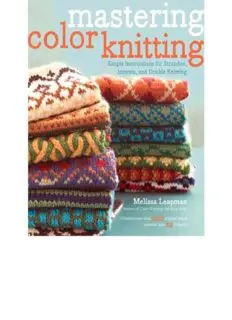
Mastering Color Knitting: Simple Instructions for Stranded, Intarsia, and Double Knitting PDF
Preview Mastering Color Knitting: Simple Instructions for Stranded, Intarsia, and Double Knitting
Copyright © 2010 by Melissa Leapman All rights reserved. Published in the United States by Potter Craft, an imprint of the Crown Publishing Group, a division of Random House, Inc., New York. www.crownpublishing.com www.pottercraft.com POTTER CRAFT and colophon is a registered trademark of Random House, Inc. Library of Congress Cataloging-in-Publication Data Leapman, Melissa. Mastering color knitting : simple instructions for stranded, intarsia, and double knitting / Melissa Leapman. -- 1st ed. p. cm. Includes index. eISBN: 978-0-307-96549-3 1. Knitting. I. Title. TT820.L388 2010 746.43′2–dc22 2010006097 Cover design by Kathleen Phelps Fashion and author photography by Alexandra Grablewski Flat fabric photography by Jacob Hand, copyright © Jacob Hand Technical illustrations by Joni Coniglio Charts and schematic illustrations by Melissa Leapman Technical editing by Charlotte Quiggle Thanks to the Craft Yarn Council of America (www.yarnstandards.com) for its Standard Yarn Weight System chart. v3.1 Contents Introduction CHAPTER 1 Getting Started Reading Color Charts Using the Pattern Treasuries Color Knitting Fundamentals Designer’s Workshop: Choosing a Color Palette CHAPTER 2 Stranded Knitting Stranded Techniques Stitch Patterns Using Steeks Designer’s Workshop: Designing for Stranded Knitting Pattern Treasury of Stranded Knitting Projects Stripes ’n’ Dots Throw Pillow: Working Stranded Knitting in the Round His and Hers Reflection Hat: Changing Pattern Colors David’s Favorite Fair Isle V-Neck: Using Steeks for Shaping Fleur de Lis Jacket: Increasing and Decreasing in a Steeked Garment CHAPTER 3 Intarsia Knits Preparing Yarns Intarsia Techniques Managing Yarn Tails Designer’s Workshop: Painting with Stitches Pattern Treasury of Intarsia Projects Gaylen’s Dress-Up Sweater: Practicing Basic Intarsia Techniques Country Quilt Block Pillow: Knitting a Geometric Intarsia Motif Traveling Triangles Jacket: Increasing and Decreasing in Intarsia Kilim Sampler Throw: Combining Colorwork Techniques CHAPTER 4 Reversible Two-Color Double Knitting Casting On for Double Knitting Double-Knitting Techniques Shaping in Double-Knit Fabrics Binding Off Charts for Double Knitting Designer’s Workshop: Designing for Double Knitting Pattern Treasury of Double Knitting Projects Winter Warmer Scarf: Creating an Unlike Reversible Fabric Vegas-Style Coasters: Reading Charts for Flat Double Knitting Memories-of-Vail Hat: Making Decreases in Double Knitting Snuggle-Up Baby Blankie: Creating an Opposite Reversible Fabric General Techniques Knitting Techniques Finishing Techniques Abbreviations and Symbols Yarn Choice and Substitution Resources Acknowledgments Index Introduction Yarn is the medium with which we knitters perform our craft, but if you ask any knitter what makes one project more interesting to make than another, the response will probably center around color. By combining colors together you can create projects that showcase graphic motifs, geometric patterns, and other designs. To me, it’s one of the most exciting, fun things you can do while knitting. In my recent book, Color Knitting the Easy Way (Potter Craft, 2010), I explored the fundamentals of color knitting and showed you how simple and, yes, how easy color knitting can be. We used stripe patterns and slip stitches to highlight the infinite fabric possibilities available using just one color of yarn per row. It’s a perfect introduction to, refresher for, and resource on color knitting, and this earlier book is chock-full of original stitch patterns and projects, as well as color wheels to help you choose colors for your projects. As knitters, we often yearn for the added complexity—and interesting challenge —of knitting with multiple colors in a row. In fact, the desire to learn stranded Fair Isle knitting is what drove me to learn how to knit as a teenager! Knitting with more than one color at a time may be more advanced, but it doesn’t have to be complicated or difficult. In Mastering Color Knitting you’ll find everything you need to take this next step in color knitting, using as many color yarns as you like. You’ll quickly master three of the most popular types of multicolor knitting: stranded colorwork, used to create geometric patterns such as those used in traditional Fair Isle patterns; intarsia knitting, used to knit pictorial images as though the knitted fabric were a canvas upon which to “draw” stitches; and double knitting, used to create a reversible fabric that miraculously appears to be stockinette stitch on both sides! Once you learn the basics for each technique, practice your new skills by creating projects for yourself, your friends, and everyone on your gift list. Each chapter includes four sample projects to get you started. With the simple instructions and beautiful patterns in this book, you will be able to create seemingly difficult colorwork that won’t scream “I’m a newbie!” Throughout, I’ve shown not only the how-to’s for each technique but also their wondrous— and endless—possibilities. Designer’s Workshops in each chapter explore topics from how to choose and combine colors based on scientific color theory to ways to design and incorporate graphic images in your knits. And treasuries of unique stitch patterns allow you to pick a pattern, apply it to a project, and knit away! You can even use knitter’s graph paper (included) or common computer software to design—and masterfully knit—your own motifs. Tips and tricks entitled ColorPlay are scattered through the pages to guide you every step of the way. If you are completely new to color knitting or need a quick refresher on the fundamentals, don’t be intimidated. Complete instructions for basics such as reading charts, starting a new yarn, and carrying yarn are covered in Chapter 1, as well as fail-safe shortcuts for choosing and combining colors for any project. A comprehensive section on general techniques, abbreviations, and other resources can be found at the back of the book. So gather the yarns you most enjoy working with in all your favorite colors and let’s get started. There’s so much to explore!
